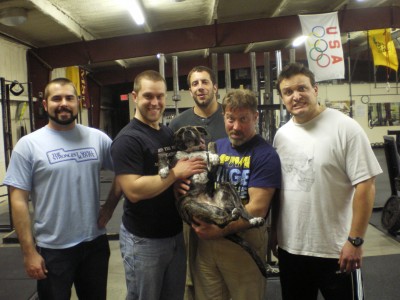Female to another female:
“I was looking for some new shoes the other day and just so you know Dicks Sporting Goods is not dicks.com.”
I didn’t realize how many of you were still lifting without shoes. I’d like to go on record, much like I did with belts, and say that if you do not lift with a pair of shoes, then you are an idiot. Here’s why.
The two primary purposes of wearing weightlifting shoes is so that they support the foot as well as the proper mechanical positioning of the body while under a load. The metatarsal strap(s) on a lifting shoe help hold your food in place and allow the structure of the shoe to reinforce you foot properly. If you lift barefoot, you are missing out on this support, and subjecting the foot to weird stress that it isn’t supposed to experience. And trying to make the painstakingly asinine argument that “we didn’t evolve with shoes” is a reason for not wearing shoes is ignoring the fact that we didn’t evolve with barbells either. I guess we should stop pooping indoors too, then. Jackass.
The metatarsal strap helps reinforce your foot as well as holding your foot in place while it is in the shoes so it doesn’t slide around. The wide sole provides more stability via the increased surface area. The non-compressible sole ensures that all of the force that you are attempting to apply to the ground goes all of the way to the bar. Think in terms of the deadlift: the initial portion of the pull has your quadriceps concentrically contracting so that they extend the knee while your hamstrings isometrically hold the back angle in place. The majority of the muscles in the back are isometrically holding their position as the force is transmitted up the back, to the traps and rhomboids, to the shoulder blades, to the arms and hands, and to the bar. In the beginning of that pull, if your back rounds or your arms are bent prior to the pull, some of the force you are wanting to go through your system is being lost. The same thing happens when you have squishy soles on (and yes, Chuck Taylors compress). Would you rather deadlift on a solid surface or a water bed? If you are going to invest lots of time and effort in doing things that are dependent on pushing against the floor, why are you okay with half-assing this endeavor? I am not okay with your lackadaisical shit, and this is why this website exists.
The additional heel that weightlifting shoes provide is pretty important too. Some heel lift puts the foot at enough of an angle so that the shin has some forward angle which slightly allows the knee to be flexed more. This little bit o’ knee flexion allows more quadriceps to be involved in pulling or squatting. This is good because it increases the efficiency of the movement, and it adds in more muscles to the movement. As a general rule, more muscles = good, less muscles = bad, ooga booga.
However, the heel height is dependent on how you pull the bar off the ground. Conventional weightlifting exaggerates the heel lift because they want the bar over the balls of the feet along with ankle flexibility considerations. The problem is that über amounts of heel lift produce too much knee flexion which reduces the tension of the hamstrings (since it is a muscle group that crosses both the hip and the knee). Having slack hamstrings does not help the back to be maintained, nor is it something that promotes sweet hip extension (when lifting, pervert). How you pull the bar off the floor is a consideration for how much heel height you want in the shoe, but how you pull is a discussion that has been documented elsewhere.
Anthropometry, or limb lengths, can also alter heel height considerations. It just depends on how freaky your ratios are. A good rule of thumb is that a 1/2″ heel will be “about right”. This is why we featured the Rogue Fitness shoe yesterday. Some shoes have heel heights around 3/4″, and those aren’t too shabby either. I have a pair of VS Athletics that are 3/4″ and have worked well for a year and a half. I cannot, however, pull heavy in them very effectively (due to Tyrannosaurus arms), so my rack pulls or deadlifts are done in a shorter heeled shoe (I actually used the pair that was in the video , but Rip gave those to Hom). Yesterday Gant told me that he paid around $60 for his pair of VS, and then $10 to get the heel chopped down. I estimate his heel height is about 1/2″. His self-esteem is much smaller, though.
Yes, spending money on shoes may not be glamorous, but you are sacrificing useful training by doing so. If you are going to by the milk, eat the meat, lift the weight, lift the girls — it will be facilitated with improving the relationship between the ground and your foot. You can find relatively cheap shoes on VS Athletics’ website as well as some others, and you can always go to a shoe tailor to get the heel reduced. Also, as I mentioned in the video, if you can get neoprene soles on your shoe, it won’t ever slip. The soles on my shoes have worn from clean and jerking, and I slip periodically on a platform in our gym. As a general rule, slipping with 350+ pounds overhead = bad.
Summary: Lifting shoes = good + necessary. Not having them = bad + stupid. Zug zug.
———-
Kevin visited the gym. If he wants to do a write up, he is welcome to. Here is a picture of some of us. The most important member of this picture is my pup, Leda.

Kevin, Justin, Leda, Gian, Rip, and Chris
